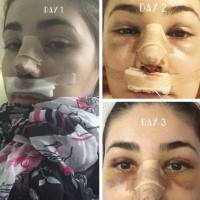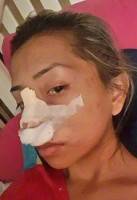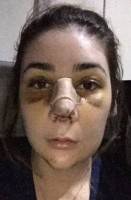How to reduce swelling after rhinoplasty?
Swelling after a rhinoplasty can last for several weeks so it’s completely normal that you are not seeing the final results of your procedure yet. I would recommend trying to stay patient and allow yourself to go through the healing process.
Your nose went through changes so it’s important to allow for proper recovery. (Carlo Honrado, MD, FACS, Los Angeles Facial Plastic Surgeon)
Rhinoplasty swelling
Your story is typical and expected after rhinoplasty. When the splint is removed the nose looks thin, but then swelling sets in.
It varies considerably how long the swelling takes to resolve, but it will continue to go down for several months and takes patience to appreciate the final result. (Ronald J. Edelson, MD, San Diego Plastic Surgeon)
Swelling can really vary depending on the patient. It can take several weeks for the initial swelling to occur, then months for it to subside.
Please wait a few months before evaluating your results. (Jerome Edelstein, MD, Toronto Plastic Surgeon)
Swelling Following Rhinoplasty May Last for Several Weeks
Rhinoplasty surgery is frequently accompanied by significant swelling. It’s not unusual for this swelling to last for several weeks.
In most cases, small amounts of residual swelling may persist for up to a year following surgery.
After two weeks the majority of patients are comfortable resuming their normal lives and going out in public. In the immediate postoperative period, nasal splints, elevation of the head, and ice can be used to minimize swelling.
It’s highly probable that your findings are related to swelling. It’s important that you discuss these issues with your plastic surgeon.
Your surgeon should be able to recommend the most appropriate course of action to obtain the best possible rhinoplasty result. (Richard J. Bruneteau, MD, Omaha Plastic Surgeon)
Swelling, Healing and Recovery After Rhinoplasty Nose Surgery
Swelling after rhinoplasty surgery can be quite severe. The initial splint which is usually left in place for one week can control this to some extent, but it is often the case that after the splint is removed there can be some additional swelling in the area. Also, the swelling will continue to go up and down for several months after surgery.
The swelling will increase when the temperature is hot, when you get upset or angry, or if you are physically active. Two weeks following surgery is still very early, and at least 50% of the swelling is still there.
By approximately one month after surgery about 75% of the swelling will have resolved. The remaining 25% of the swelling will not be very noticeable, and will slowly resolve from that point up until about 9 months following surgery. (Cory Goldberg, MD, Toronto Plastic Surgeon)
Nose Swelling After Rhinoplasty
The swelling and bruising related to the rhinoplasty involves the nose, the upper and the lower eyelids. Theses will get worse withing the first 48 hours and start getting better.The swelling and bruising around the eyes go away mostly within the first week to 10 days.
The nose swelling will, to great deal, go away withing this time as well. However, there will some minor swelling that will come and go up a year, specially in the mornings, during the menstrual periods and after salty foods. Avoiding salty foods is very helpful during this healing period. As the time goes by, this fluctuation in swelling will become less and less. On rare occasions there is bruising of the white portion of the eyeball that will disappear in 3-4 weeks.
Uncommon dense bruising of the lower eyelids may last 3-4 weeks. Use of vitamin K and Arnica cream may help faster resolution of bruising. These can be purchased from the herbal stores without a prescription. (Bahman Guyuron, MD, Cleveland Plastic Surgeon)


